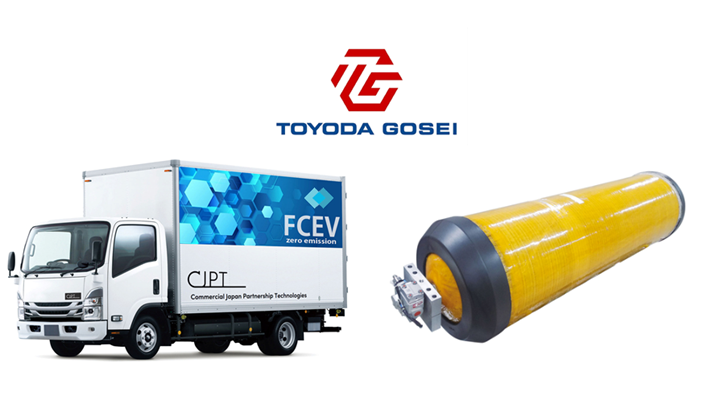Toyoda Gosei showcases large H2 tank for commercial vehicles
Lineup expansion aims to meet the wider use of fuel cell vehicles that require long driving range and fast refueling.
Toyoda Gosei Co. Ltd. (Kiyosu, Japan) has launched a large high-pressure hydrogen tank. While materials use was not cited, it can be assumed that the tank uses composites, based on the carbon fiber- and glass fiber-reinforced polymer (CFRP and GFRP) tanks used on the 2021 Toyota Mirai, and the company’s work in nanocellulose fiber-reinforced plastics. The new tanks are to be used in mass-marketed light-duty fuel cell electric trucks that are being brought to the market by Japan-based Commercial Japan Partnership Technologies Corp. (CJPT), backed by Toyota Motor Corp., Isuzu Motors Ltd. and others.
These newly developed large tanks can reportedly be filled with about eight times as much hydrogen as the passenger fuel cell vehicle (FCV) tanks Toyoda Gosei produces for the Toyota Mirai (the second generation model), which are installed in the rear of that vehicle. In developing the larger tanks, Toyoda Gosei says it applied the technology for high-efficiency storage of hydrogen the company and Toyota Motor had refined in the Mirai tanks.
Related Content
-
SMC composites progress BinC solar electric vehicles
In an interview with one of Aptera’s co-founders, CW sheds light on the inspiration behind the crowd-funded solar electric vehicle, its body in carbon (BinC) and how composite materials are playing a role in its design.
-
Co-molding SMC with braided glass fiber demonstrates truck bed potential
Prepreg co-molding compound by IDI Composites International and A&P Technology enables new geometries and levels of strength and resiliency for automotive, mobility.
-
Automotive chassis components lighten up with composites
Composite and hybrid components reduce mass, increase functionality on electric and conventional passenger vehicles.













